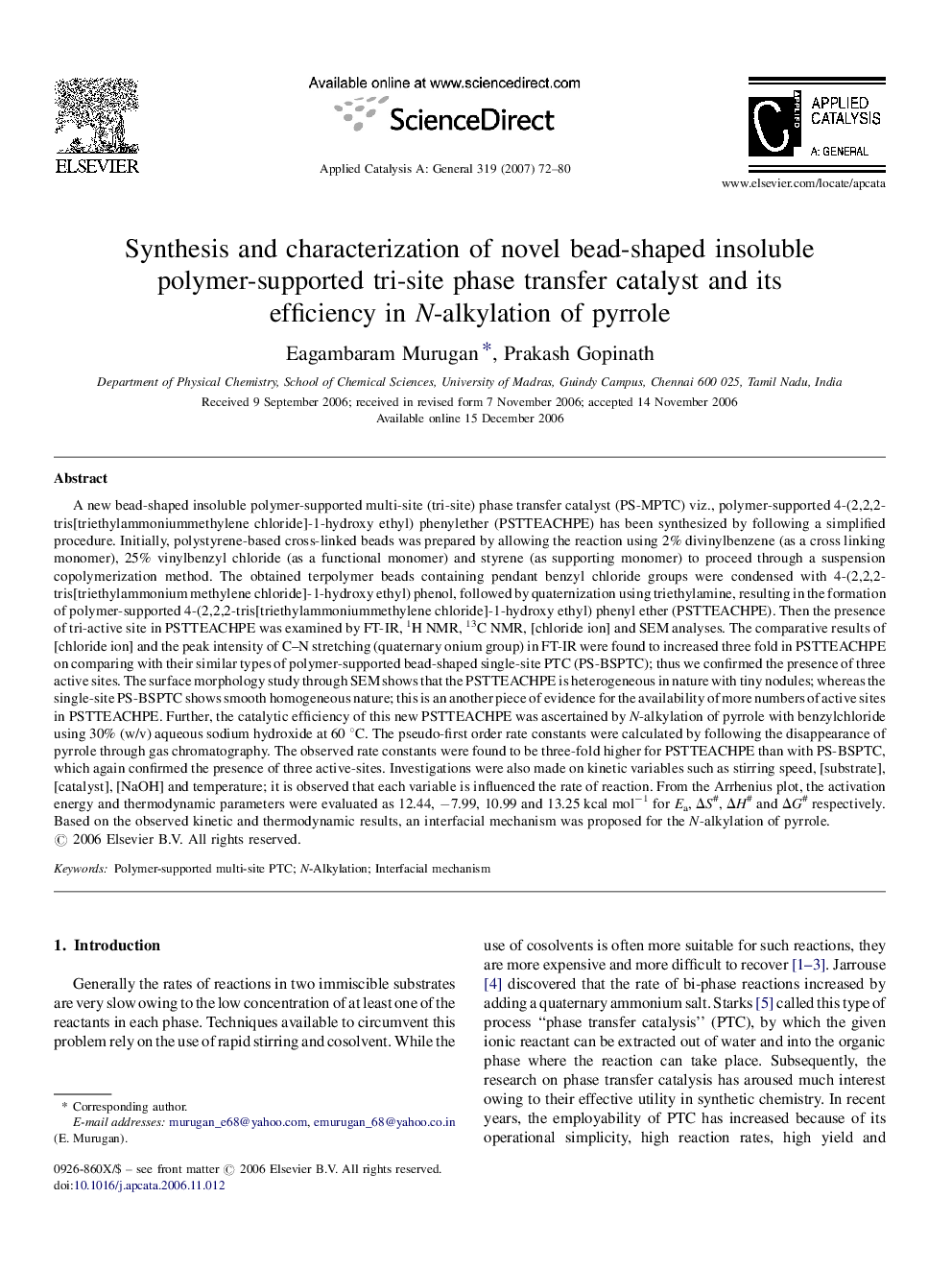| کد مقاله | کد نشریه | سال انتشار | مقاله انگلیسی | نسخه تمام متن |
|---|---|---|---|---|
| 43976 | 45998 | 2007 | 9 صفحه PDF | دانلود رایگان |

A new bead-shaped insoluble polymer-supported multi-site (tri-site) phase transfer catalyst (PS-MPTC) viz., polymer-supported 4-(2,2,2-tris[triethylammoniummethylene chloride]-1-hydroxy ethyl) phenylether (PSTTEACHPE) has been synthesized by following a simplified procedure. Initially, polystyrene-based cross-linked beads was prepared by allowing the reaction using 2% divinylbenzene (as a cross linking monomer), 25% vinylbenzyl chloride (as a functional monomer) and styrene (as supporting monomer) to proceed through a suspension copolymerization method. The obtained terpolymer beads containing pendant benzyl chloride groups were condensed with 4-(2,2,2-tris[triethylammonium methylene chloride]-1-hydroxy ethyl) phenol, followed by quaternization using triethylamine, resulting in the formation of polymer-supported 4-(2,2,2-tris[triethylammoniummethylene chloride]-1-hydroxy ethyl) phenyl ether (PSTTEACHPE). Then the presence of tri-active site in PSTTEACHPE was examined by FT-IR, 1H NMR, 13C NMR, [chloride ion] and SEM analyses. The comparative results of [chloride ion] and the peak intensity of C–N stretching (quaternary onium group) in FT-IR were found to increased three fold in PSTTEACHPE on comparing with their similar types of polymer-supported bead-shaped single-site PTC (PS-BSPTC); thus we confirmed the presence of three active sites. The surface morphology study through SEM shows that the PSTTEACHPE is heterogeneous in nature with tiny nodules; whereas the single-site PS-BSPTC shows smooth homogeneous nature; this is an another piece of evidence for the availability of more numbers of active sites in PSTTEACHPE. Further, the catalytic efficiency of this new PSTTEACHPE was ascertained by N-alkylation of pyrrole with benzylchloride using 30% (w/v) aqueous sodium hydroxide at 60 °C. The pseudo-first order rate constants were calculated by following the disappearance of pyrrole through gas chromatography. The observed rate constants were found to be three-fold higher for PSTTEACHPE than with PS-BSPTC, which again confirmed the presence of three active-sites. Investigations were also made on kinetic variables such as stirring speed, [substrate], [catalyst], [NaOH] and temperature; it is observed that each variable is influenced the rate of reaction. From the Arrhenius plot, the activation energy and thermodynamic parameters were evaluated as 12.44, −7.99, 10.99 and 13.25 kcal mol−1 for Ea, ΔS#, ΔH# and ΔG# respectively. Based on the observed kinetic and thermodynamic results, an interfacial mechanism was proposed for the N-alkylation of pyrrole.
New bead-shaped insoluble polymer-supported multi-site (tri-site) phase transfer catalyst (PS-MPTC) viz., polymer-supported 4-(2,2,2-tris[triethylammoniummethylene chloride]-1-hydroxy ethyl) phenylether (PSTTEACHPE) has been synthesized and its catalytic efficiency was ascertained by N-alkylation of pyrrole with benzylchloride using 30% (w/v) aqueous sodium hydroxide at 60 °C. Investigations were also made on kinetic variables such as stirring speed, [substrate], [catalyst], [NaOH] and temperature. Based on the observed kinetic and thermodynamic results, an interfacial mechanism was proposed for the N-alkylation of pyrrole.Figure optionsDownload as PowerPoint slide
Journal: Applied Catalysis A: General - Volume 319, 1 March 2007, Pages 72–80